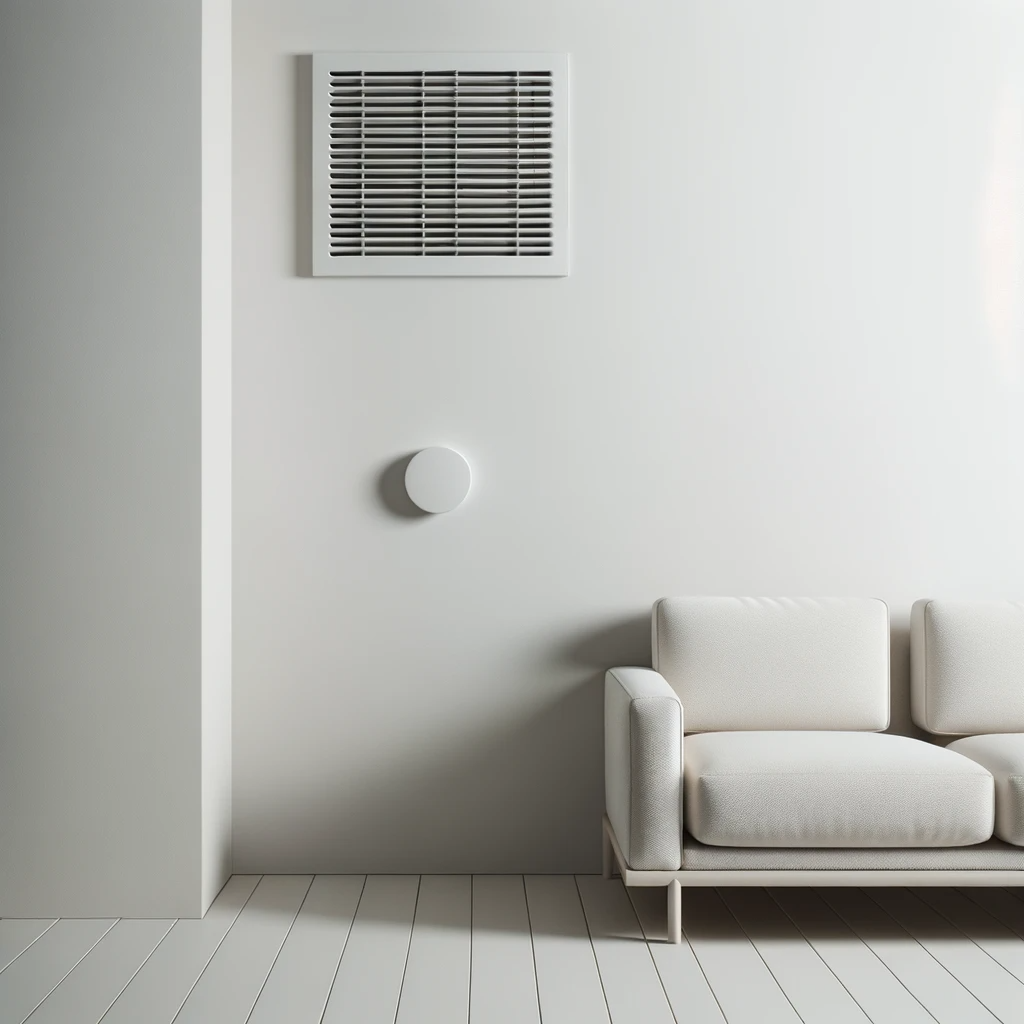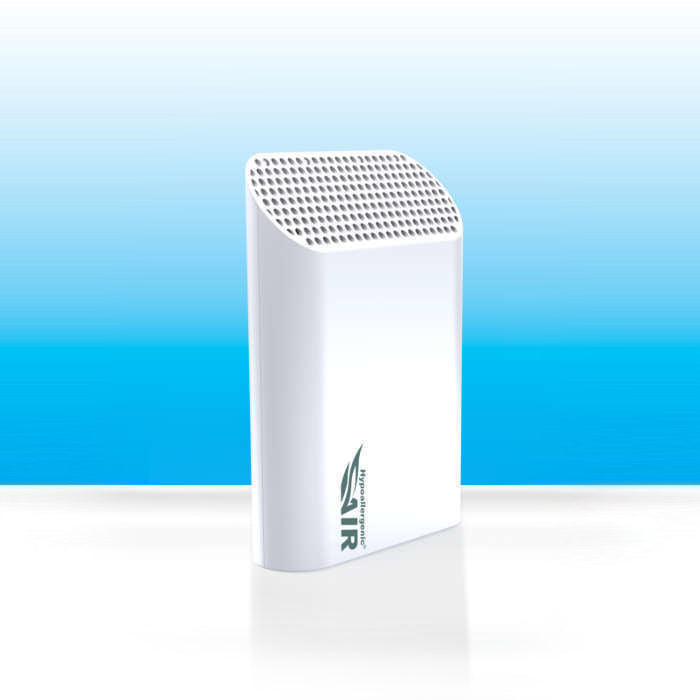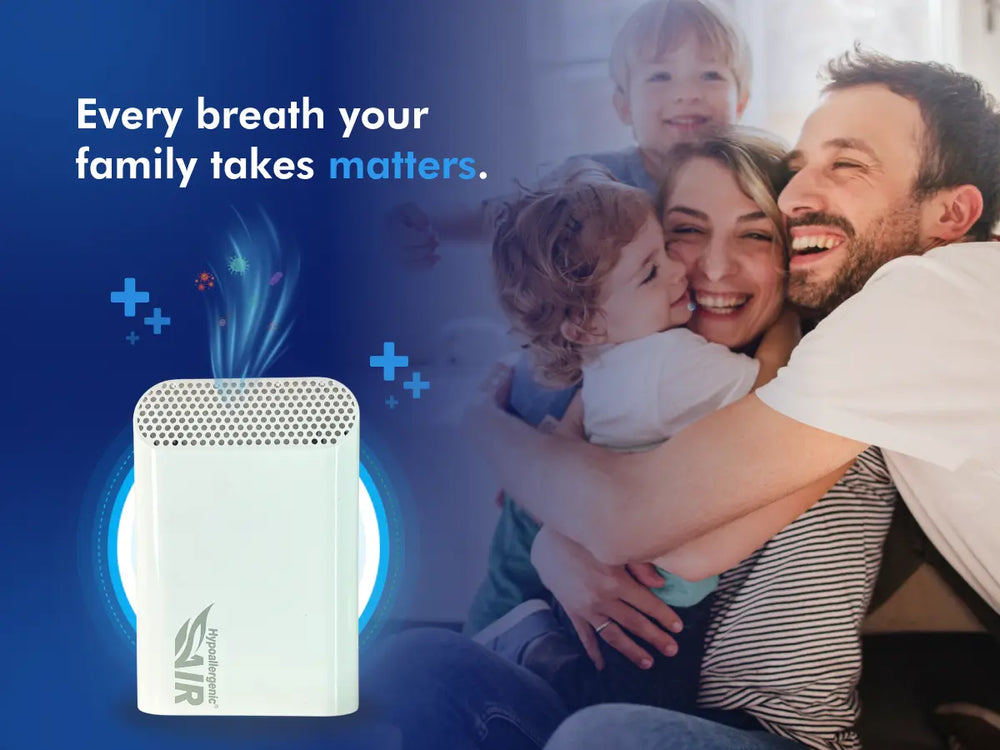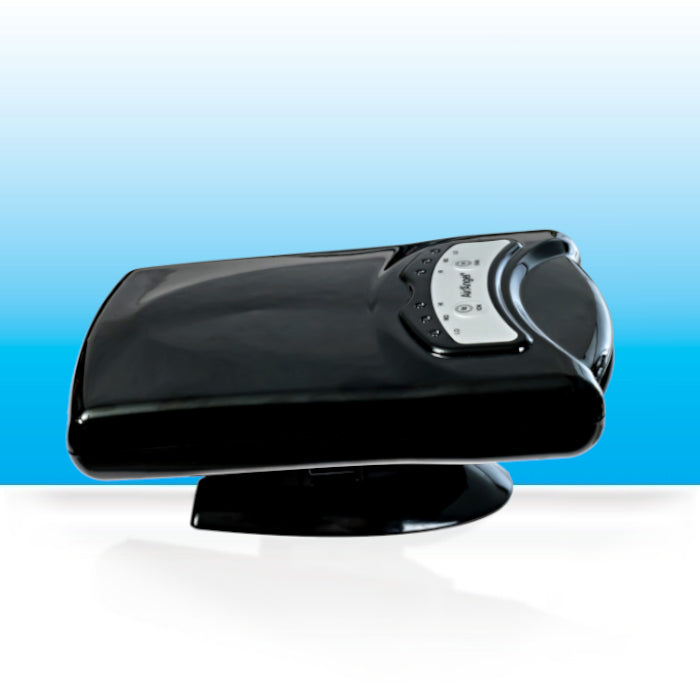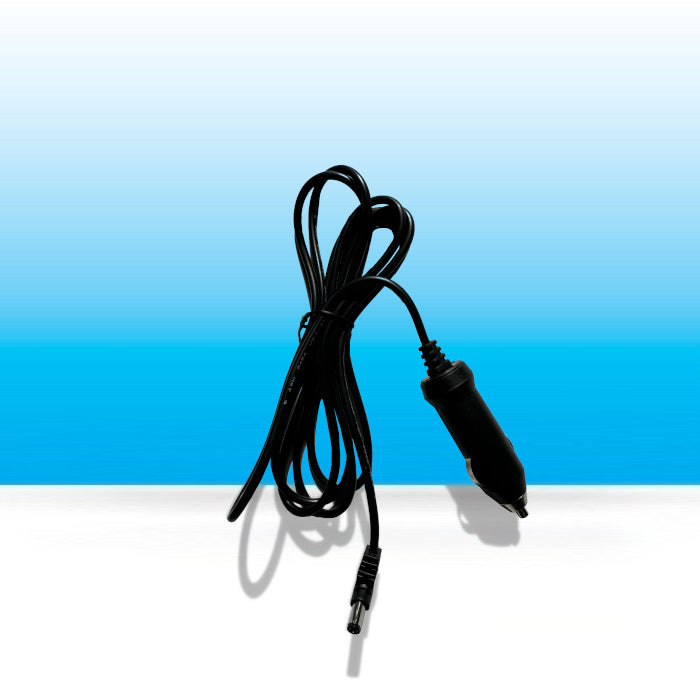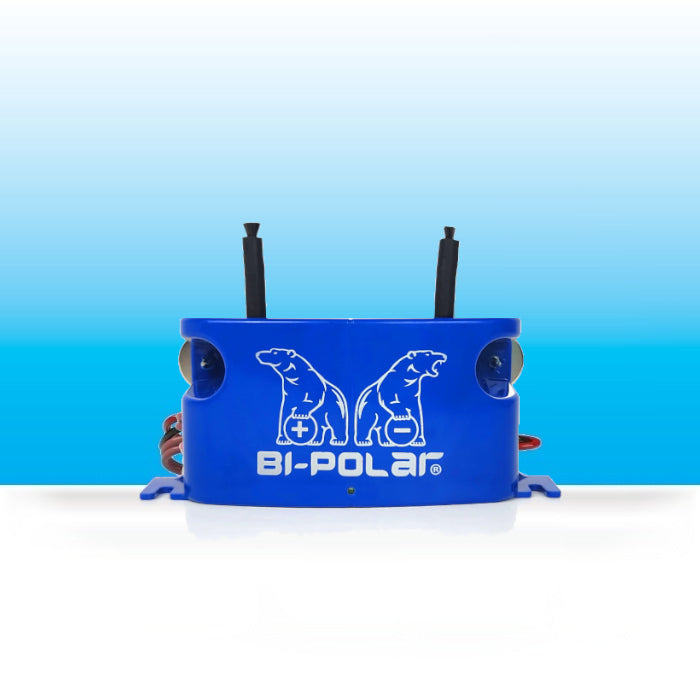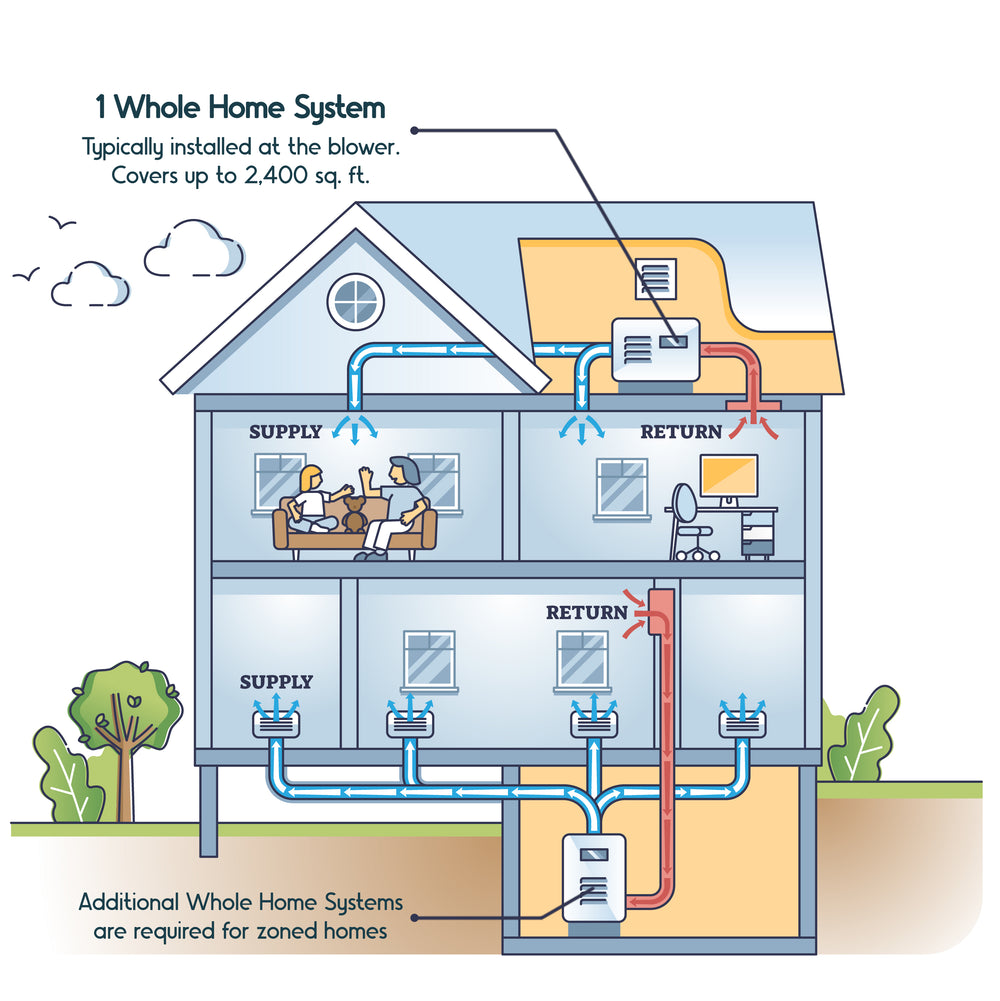Hypoallergenic Air's exclusive nanotechnology is different. It’s the single best defense against mold, viruses, allergens, odors, bacteria, and chemical gases. It doesn’t just trap contaminants; it’s proven to sanitize the air and also surfaces. It will actually kill a virus on a door handle or prevent mold from growing on a wall. We believe Air Quality is NOT one size fits all and combine various industry leading and proprietary technologies to create our various product options. For the last 10 years we've focused on real air quality solutions for commercial and residential clients around the world. We don’t sell gimmicks, just proven results. In the last hour, our technology sanitized an estimated 2 billion cubic feet of air.
Every situation is unique. We do our best to recommend units that are perfect for you but there are many variables to consider outside of our typical "coverage" estimates. We'd love to provide a custom recommendation to you. Please email us the following information to info@hypoair.com for a personalized suggestion. What is the size of your home / space that you'd like to cover? Pets? Smokers? Mold? Any special needs? Any unique concerns?
Read more in the next FAQ about estimating the proper "coverage".
We estimate each of our units to have a square foot (sq. ft.) coverage for the average room(s). All of our units provide extremely large coverage areas for their size compared to the competition.
Not only do we purify the air; we actively sanitize the surfaces. Many well known and popular air purifiers will not even say how much coverage their air purifiers are supposed to have, and if they do, you'd be surprised at how little they claim to cover. Due to the variables involved (contaminant sources, special needs, building layouts, etc.) the coverage we list for each unit is only an estimate and may require you to adjust the number or size of units in your home or facility.
Airflow issues, multiple stories, and portability: Beyond contamination levels, air flows can assist or limit the effectiveness of our units. A bedroom or basement with a door often left closed will seal off that room from the rest of the house. Our units are clearly not effective if a door or other obstacle prevents good airflow between the spaces. In such cases a unit for each space is needed. In addition, multiple stories can actually be better than a long single story floor plan. We often recommend at least 1 unit per story, but if budgets are an issue, placing a single unit in a central location in the upper story will be better. Lastly, our units are very compact and very light weight in proportion to their power.
Our largest residential unit is less than 8 lbs. This makes them portable to move about the house as needed if budgetary restrictions make multiple units not feasible.
First of all, we're sorry to hear of the trouble! Please contact us directly at info@hypoair.com for personalized assistance. If we can't troubleshoot the issue quickly, we'll be happy to process your order securely via PayPal or find another method that works for you.
Yes! We ship to most countries in the world. If you have any trouble getting a shipping estimate or processing your order, please send an email to info@hypoair.com with your full shipping address and the units you are looking to purchase.
All of our units are designed with international electrical requirements in mind. You will need an adapter for your local country's outlet type, but our products can function on any residential electrical range.
Commercial products are designed with specific electrical ranges in mind depending on application. Please contact us for help.
Yes! We work with resellers and distribution partners around the world. Please contact us to learn more.
Yes! We work with resellers and distribution partners around the world. Please contact us to learn more.
Our technology has undergone rigorous university and lab studies for over 10 years. Read more on our technology section (here) and even request lab reports if you're interested.
No, we have several product lines designed for commercial applications as well. Many of the products on the shelves of most retailers are more gimmick than they are real.
Our technologies and products have been vetted around the world in some of the most prestigious buildings and by some of the most difficult air quality issues (Dog Kennels, Industrial Exhaust, Hospital infectious disease wards, Las Vegas Casinos, etc.). It's one thing to prove it in a lab, and another thing to prove it in the real world.
All of our residential units are available to be purchased through PayPal Credit. You must have a PayPal account and apply through PayPal. After adding a product to your cart, visit the shopping cart page and select PayPal Credit. PayPal will walk you through the steps from there.
Some of our commercial products have financing or rental plans depending on industry. Please contact us to learn more.
We work with a select number of like-minded influencers and medical professionals. If interested, please contact us to learn more at info@hypoair.com
We get this question a lot, especially as homeowners try to utilize more space in their homes (like finished basements) that may not be maintained at the proper humidity or are susceptible to water intrusion.
We are going to talk about the process of safely saving the furniture. If there is a stain left over, that is purely a judgment call on the part of the homeowner: small areas of the furniture should be able to be cleaned and successfully prevented from regrowing mold. (The list of cleaners below is part of our growing collection of recommended safe cleaning products).
Larger or more visible stains caused by the mold can be unsightly…but we’re going to talk about safety here and leave the aesthetics up to you!
The safe route here is killing the mold, “cleaning” the dead mold away, then drying the area. If the stain left from the mold remains, that will need additional treatment.
It’s best to don protective equipment such as an N95 mask, and if you are able to move the furniture outside on a sunny day, this will be the best place to clean it. If it’s too large or bulky, try to remove cushions or covers that can be cleaned outside.
Consider gently covering it in plastic or not handling the moldy place while you’re moving it, because visible mold is the “tip of the iceberg” so to speak: brushing or agitating the moldy area can release a staggering number of mold spores into the air.
- Outdoor cleaning: since you are outside, you can brush off the moldy area first with a broom or vacuum it off, then proceed to the step after indoor cleaning. (You’ll want to later hose off the broom and let it dry, or throw away the vacuum bag, and clean all of the hose and attachments, to avoid spreading the spores back indoors).
- Indoor cleaning: You can vacuum using ONLY a vacuum fitted with HEPA filter. (You’ll want to later hose off the broom and let it dry, or throw away the vacuum bag, and clean all of the hose and attachments, to avoid spreading the spores back indoors). After vacuuming, kill the underlying mold without disturbing it: you’ll want to use a spray bottle that is set to “spray” and not “stream”. Lightly mist the affected area until all of the surface is damp. By dampening the mold, it will not be able to release spores into the air. Here are some solutions you can use:
- Homemade solutions: Equal parts white vinegar and water OR ½ cup borax dissolved in 2 parts water
- Concrobium Duo-Blast Mold Control Spray (safely combines a mold killer and stain remover)
- ZorbX Spray (also safe, can be used on solid surfaces too like wood)
You can use a sponge soaked in the vinegar or borax solution to remove more of the mold and stain, or folllow instructions on the store-bought spray.
Let dry: Direct sunlight is great for drying and disinfecting! If the item is indoors, make sure the air is warm and dehumidify the space (a small space heater during the winter would help, or fan and dehumidifier during the summer).
Once the item is clean and dry, take a photo of the affected area and revisit it every few weeks, to see if the moldy area has regrown. If necessary, you can still save upholstered furniture if the moldy area is not usually seen (the back, for example), by cutting out the affected fabric after killing the mold and resewing some new fabric onto it by hand. This not only eliminates the chance of mold regrowing in that area, it lets you see if the mold has spread inside the upholstery.
Off-gassing is the release of airborne chemicals. Newly manufactured products can off-gas for years. Paints and finishes can off-gas, leading to the advent of low- and zero-VOC (volatile organic compound) paints. That “new car smell” is really the result of off-gassing! You may recall specific incidents in the news where off-gassing of furniture or paints in buildings caused illnesses such as recurring headaches, breathing problems, and more systemic immune system responses to the inhabitants. Usually the very young and elderly are most at risk, but anyone can be affected.
To avoid off-gassing, if you buy a new piece of furniture or area rug, try to isolate it in a larger room with outside air circulating (a carport or ventilated garage for example) for several weeks to get rid of some of the peak levels of VOCs. If you can’t off-gas the new item outside your living space, leaving a hypoair unit in the room will help combat the VOCs. In vintage or used items, they have most likely off-gassed completely, but beware of those cleaning products and varnishes you may use to “spruce up” vintage things! Check the label when buying paint, new appliances and floorings like vinyl. Even ceramic floors and granite, which are touted as a "hypoallergenic" choice of flooring and countertops, need to be sealed...and sealers may have VOCs.
To monitor off-gassing, you can hire a consultant to assess your home, OR monitor it yourself. VOC measurement is typically not accurate with cheaper units, so it's best to do research before buying. Here are two companies to check out:
- AtmoTube has a portable sensor that can monitor temperature and humidity, along with PM2.5 (small particles), VOCs, and CO2. Ideally, you should try to do a “baseline” reading of these before introducing new furnishings.
- Airthings also has affordable sensors that can monitor radon in addition to PM2.5, VOCs and CO2.
Radon is a colorless, odorless gas that is emitted from soil, rocks and water containing radium or uranium. It is radioactive and long-term exposure to radon is linked to increased rates of lung cancer. Before buying a home, you can ask for radon testing, and if necessary, have a radon mitigation system installed. These systems can work well to bring a home that is in high radon range to very low range.
Wondering if you live in an area with high radon gas rates? You can go to this page to view air sensor readings from around the world by Airthings monitors. (visit Airthings.com or click on Airthings at the upper right on radonmap.com). If you’ve never had your home tested for radon, it’s a good idea. Airthings also makes sensors that monitor radon in your home.
HEPA stands for High Efficiency Particulate Air, and describes a standard of filtering very small particles out of the air. Scientists have discovered that the most damaging particles to our bodies are very small—such as in wildfire smoke, or airborne mold or bacteria. They can get deep into the lungs, and even the bloodstream. The particles are measured by micrometers (which are also called microns), which is a millionth of a meter. The diameter of a human hair is 50-100 microns, but HEPA filters can remove particles 100x smaller, like 0.1 microns.
There are three types of entrapment that may occur as particles are drawn through the filter. Inertia causes some large particles to collide directly into fibers instead of sweeping around them with the accompanying airflow. Diffusion occurs when smaller particles travel in an erratic fashion through the airflow and are impeded by fibers. Interception occurs when the particle travels closer than its radius to the fiber, “brushing” it and becoming stuck. Interestingly, particles around 0.3 micrometers in diameter are the most difficult to filter out of the air, because they are affected least by these methods. So, HEPA filters are rated on their ability to remove this size particle—0.3 micrometers. They do so with greater than 99.95% efficiency. There are 2 ratings of HEPA: H13, which removes at least 99.95% of 0.3 micron particles, and H14, which removes at least 99.995% of 0.3 micron particles. Then, you can get into ULPA (Ultra Low Penetration Air) filters, which can remove more than 99.999% of 0.12 micron particles or larger.
There are many standalone HEPA air filter units on the market that can be used in conjunction with our products. If we receive a call from a customer who is severely allergic to mold or dust, we generally recommend an air purifier unit in conjunction with a HEPA filter unit.
Great question! You shouldn't have to compromise your health when you travel.
Regarding hotel rooms: In marketing our products, we have spoken with a number of hotels around the world and usually, hotels do not depart from standard cleaning and air quality procedures unless their clients ask. It makes sense, because wouldn’t we all want better air quality if it was as simple as flipping a switch? So, ask! It may take a little extra effort to call the hotel for a reservation instead of booking rooms online, and it may cost 3-5% more for the room, but you will never know without asking. Here’s what some hotels can provide :
- Deep cleaning with plant-based and anti-microbial cleaning products
- Portable air purifiers
- Wall-mounted air purifiers
However, it is easier to improve on a clean room, than bring an “average” room up to the air quality to which you are accustomed.
If no cleaner room options are available, HypoAir products like Mold Guard and Air Angel are small and easy to travel with (see our FAQ on Voltages) and we encourage customers to bring them along if possible. You can position an Air Angel in your hotel room and go to dinner, coming back to fresher air and sanitized surfaces (make sure to turn back the bed sheets if that seems to be a concern!).
One of HypoAir’s key investors ran his own test: he intentionally booked a hotel room that was classified as “smoking” just to test the power of a HypoAir unit. The longer the unit ran, the further away from the unit the space was purified. We do NOT recommend staying in a smoky hotel room and would much prefer you start with a cleaner room than try to mitigate a heavily polluted space. Better yet, you could run your own test in your teenager’s room or closet, to positively show the power of the technology!
Regarding plane travel: Neither the Germ Defender nor Air Angel are equipped to run on battery, however customers have carried them onto the plane itself and plugged them in, with no problems at security checkpoints. In the case of the Air Angel, make sure you have the cord with you.
We would caution the use of wearable air purifiers (necklace type) as these are typically negative-ion generators, which produce ozone and according to this study, only deactivate about 10% of the contaminants within 20 cm (~8 inches). Circulation in an airplane is such a dynamic environment, that even the powerful Air Angel, which is designed for 300+ sq. ft, will struggle to purify the air around you. However, it is certainly better than nothing, and can mitigate concentrations of germs.
In the US, we are accustomed to 110-120 volts and the two- or three-prong plug. If you travel or live outside the US, you’ve likely come across this problem before: what voltage and what plug do I need?
By far, most of the world uses 220-240 volts, which would fry an appliance designed for 110v. However, small appliances like hair dryers have also become more “dual-voltage” and transformers are increasingly small and travel-friendly. Plug adapters (they just change the plug type and have no effect on voltage) are commonly found online or in travel stores at the airport. Here’s the scoop for HypoAir products:
Germ Defender/Mold Guard: These are rated for 120/240v, so voltage is not an issue. You will need to get a plug adapter, however, for countries other than the US. Due to expensive testing requirements, these units are not CE certified (determined to meet EU standards).
Air Angel: The unit itself uses 12V DC power, however, it comes with a converter cord and plug which use dual voltage 120/240v. The converter cord and plug are CE rated. You will need to get a plug adapter for plugs outside the US..
Whole Home Polar Ionizer (BP-2400): It’s best to check with an HVAC installer who has examined your HVAC system, to purchase the right unit. We have 3 different voltage options, which all emit the same output. All three need to be "hard-wired", meaning there is no plug and professional installation is necessary:
- 110 v unit: always accessible in the US
- 24 v unit (DC current): typically installs directly into the HVAC system in the US
- 240 v unit: more common for international commercial applications
Also, our “compact” version of the BP-2400 is available for around 1% of installs where the blower is not accessible. Our exchange and return policy on the BP-2400 is very flexible as we want you to have a successful install and start reaping the benefits from it!
This is a question we receive A LOT. Of course, we all want to SEE the before and after benefits of our efforts: making efforts to lower humidity, or installing an air purifier, should make mold go away, right? Yes, and no!
Mold is tricky. Because it grows in all climates and places (even the desert and Antarctica), statistically 100% of homes have mold, and you can easily spend more on testing than the mitigation would cost you. At HypoAir, we are interested in before and after concentrations (not just types of mold). Also, it’s best if the outdoor levels are used as a baseline.
If you are a homeowner interested in knowing the concentrations of mold in your home, the inexpensive ($10-$20) petri dish test kits found in many big-box or hardware stores may give you an incomplete picture. Different types of mold may settle in the petri dish and grow, but these will not give the concentrations present in the air, nor will they detect non-viable mold (dead spores), which also cause respiratory and health problems. Also, most of these tests have dishes that are not dated for expiration, as the mold food used to capture the spores indeed can expire and not contain the moisture and nutrition the mold would find in your home. (yikes!)
Cassette testing is better than petri-dish testing in our humble opinion. Cassette testing involves using a specific testing device that blows air through an orifice onto a slide with an adhesive coating (the cassette). The adhesive coating traps the spores and prevents them from being washed off the slide when they are stained for analysis. These cassettes are then mailed to a lab for analysis. This type of testing will give a better picture of concentrations, because the sample is taken over a discreet shorter period of time (from 30 seconds to 20 minutes), versus the hours or days used in petri dish testing. Also, the air sample is forcefully directed onto the cassette, instead of relying on air currents in the home to settle it onto a petri dish (which can also be affected if the HVAC kicks on during testing!) Cassette testing by gotmold.com has the most bang-for-the-buck of product and service we've found in the US. They are very transparent about the product (a reusable air sampler with batteries included, the number of cassettes you will get, and all lab costs included), as well as the report/info you get (click here for a sample gotmold? report).
ERMI: The EPA has developed the Environmental Relative Moldiness Index (ERMI), which grades test results into below average mold burden (score of -4, for example), average (score of 0), and above average (for example, score of 5). ERMI testing relies on taking dust samples instead of air samples, on the premise that more mold spores are present in the dust, and can be identified down to the species level. To many experts, the index score itself is not very meaningful, as family members can experience ill health effects within a home that scored as a “low mold burden”. The species of mold, bacteria and mycotoxins identified and their sources, however, could provide very important information about where and how to mitigate the toxins. (The EPA states on their site that ERMI is not recommended for home use, except as a research tool. Despite this, there are several firms that offer ERMI testing. Mycometrics, Envirobiomics, EMLab P&K and AssuredBio are some test providers. You should be clear about the sampling process, compare the types of molds that each provider will assess, and whether an outdoor control sample will be necessary (some firms do not claim it is necessary).
Finally,in-home professional services can be well worth the investment, because an experienced inspector can inspect your home and see signs of contamination with which the average homeowner is not familiar. Sometimes with water leaks behind walls, the mold colony is hidden and requires drilling through damaged drywall to access. Also, they can recommend the proper steps for remediation. You should look for accreditation when considering professional services: the ACAC website is a great place to start. They have a locator by zipcode that makes it easy to find a professional in your area.
Mini science lesson here! Many ionizers on the market are negative ionizers. This is an older technology that only produces negative ions, which are oxygen atoms with an extra electron. These ions increase static electricity because they are not balanced with positive ions. Static electricity is the imbalance of positive and negative ions in different areas of the atmosphere or a surface, which build up until the charge differential is too great. The “electric” part comes when the charge is released and the ions spontaneously rearrange to a more balanced state—like mini lightning bolts on a sweater, your hair, etc. The charge passing through the air creates small amounts of ozone in the case of static electricity from a negative ion machine, or larger amounts of ozone in the case of actual lightning during a storm.
Negative ionizers are also known to produce a “black wall syndrome” as it creates a bubble of static around the unit, clogging the unit’s systems and failing to travel far out into the environment.
HypoAir products with our Polar Ionization technology remove static electricity because they create both positive ions (hydrogen) and negative ions (oxygen), which balance the ions present on surfaces and prevent the charge differential from occurring. Just like nature outside during non-storm conditions, there is no appreciable charge differential, no static electricity, and therefore no ozone generation.
What about the Air Angel? Where does the small amount of ozone come from?
First of all to put things in perspective, the Air Angel has been certified by the strictest regulatory agency in the world (California Air Resource Board, or CARB) for safe ozone production. It was placed in a small chamber and produced a peak or maximum ozone of just 0.02ppm. This is far less than you will be breathing outside in a national park (check out the live ozone readings in many national parks here).
In addition to Polar Ionization, the Air Angel employs an AHPCO cell (Advanced Hydrated Photo Catalytic Oxidation). This cell contains a UV light source, the rays from which excite the AHPCO nanometal catalyst. This creates a small amount of ozone (less than 0.02 ppm). Minimal ozone adds the benefit of combating VOCs (Volatile Organic Compounds). Examples of VOCs are gases such as smoke (which also has particulates), bleach or cleaning product vapors, or cooking odors, some of which are harmful and some are not. The AHPCO cell then adds a layer of protection against VOCs , which polar ionization alone cannot affect. The Catalytic Molecules also are extremely effective at grouping around particles in the air, causing them to become heavy and fall, removing them from the air you breathe.
Yes! SARS-CoV-2 is the virus that causes the disease COVID. To our knowledge, the Germ Defender was the first air purifier in the world that was tested against SARS-CoV-2. This was accomplished at Microbac Laboratories, one of the few CDC-approved labs in the world to work with SARS-CoV-2. The summary results of this test can be viewed here. Basically, Germ Defender caused reduction of 94.7% of SARS-CoV-2 on surfaces. Additionally, the Kitasato Institute Medical Center Hospital, one of the world’s most prestigious viral research organizations, tested the inactivation of the feline coronavirus (FCoV) when exposed to polar ionization, demonstrating 99.7% virus inactivation after 40 minutes. This test used a much lower ion density than provided by the Germ Defender.
Here is how the technology works: Positive hydrogen ions (H+ ) and negative oxygen ions (O2 – ) cluster around the spike protein of the coronavirus. This spike protein on the surface of the virus is what attaches to an organism and triggers infection. Once clustered around the spike protein of the virus, the ions are converted to hydroxyl radicals. By stealing hydrogen from within the spike protein, the ions react and combine chemically to form water (H2O). Because the spike protein is damaged, the virus cannot infect cells even when introduced into the body (it is unable to make you sick). These polar ions are emitted by all 3 units (Germ Defender, Air Angel and the Whole Home Polar Ionizer) to inactivate viruses.
The AHPCO technology has not been singularly tested against SARS-CoV-2, but previous tests against the MERS Coronavirus were very successful. The same report cites a 99.5% kill rate of MERS on surfaces in a test performed at Microbac. The catalytic molecules produced by AHPCO break through the protein and disrupt the RNA/DNA of the virus (by oxidation) to keep them from replicating even after the virus has moved beyond exposure to the catalytic molecules.
Ozone is naturally present in earth’s atmosphere. It is sometimes recognized by smell after rain/thunderstorms, and it purifies the air. While potent and natural outside, ozone can at higher concentrations be irritating especially for those that seem to have other sensitivities like mold allergies or an asthma condition.
Models MG-100 (Germ Defenders/Mold Guard units) and BP-2400 (Whole Home Polar Ionizer) emit zero ozone. Air Angel is certified at virtually zero ozone; therefore all of these units are recommended for even those with the most sensitive breathing conditions.
The aim of HypoAir units concerning mold is to (1) kill/suppress growth on surfaces, (2) remove the mycotoxins - chemicals produced by its growth - through breaking down their molecular structure and converting them to harmless water/CO2, and (3) remove any spore or dead mold spore out of the air.
1) Kill/suppress growth on surfaces: We must clarify that only mold exposed to the ions in the ambient air is affected, not inside closed cabinets, through walls, or inside furniture (like couches). We want to replicate the conditions found in the outside air by introducing natural countermeasures to mold growth.
Polar ionization removes hydrogen atoms from the surface of the mold, interfering with its ability to reproduce (send out more mold spores). AHPCO technology sends out other catalytic molecules into the air, including hydrogen peroxide, which is a compound that releases oxygen rapidly and causes decomposition of the mold.
2) Mycotoxins are toxic chemicals produced by mold and other fungi as they grow. Mycotoxins even in low concentrations cause disease in humans and animals. Polar ionization (also called cold plasma) has been shown to reduce mycotoxins in foods and is promising in this area because it is economical and does not appreciably change the food wherein the mold or mycotoxin is interspersed. Similarly, when a HypoAir unit is in continuous operation in a space, the ions are continually attacking mold “to cause chemical breakdown of mycotoxins through various pathways resulting in degradation products that are known to be less toxic.” (abstract)
3) Specifically, we aim to get particles grouped together so they're less dangerous and out of the air. We are most concerned with particles that are 2.5 microns (“PM2.5”) and smaller as these particles are the most difficult in general for filters to capture or for our natural defenses to protect against. PM2.5 is typically the category of particles associated with more serious respiratory issues as they can penetrate deeply into the lungs. (For reference, a human hair has a diameter of about 50-100 microns!). By grouping contaminants into larger particles, it makes all filtration in your house more effective (like the filters in your HVAC). We do recommend cleaning floors and counters regularly while using HypoAir products, using a good quality HEPA vacuum just like you would any other time.
We have several HEPA vacuum recommendations at different pricepoints and options:
- Most economical: Vacmaster Pro 8 gallon Certified Hepa Filtration Wet/Dry Vac
- Professional and Home Cleaning: Emerson ProTeam Vacuums
- Water-based filters: Sirena Vacuum Cleaners
- For our European clients: Taski Aero Vacuums
HypoAir products mimic the oxidizing reactions which occur naturally in the troposphere (the lowest region of the atmosphere), which you can read about in this NASA report.
UV light shining on the catalyst in the AHPCO cell creates a minimal amount of ozone (as discussed in the FAQ on ozone). In the presence of water vapor and this small amount of ozone, the UV light also creates hydroxyl radicals. These radicals are very common in the outdoor air, and act as cleaners. Because they have an extra electron, they are very reactive with many pollutants in the atmosphere including methane, carbon monoxide and PCBs. It reacts and binds with these atmospheric pollutants to form a more stable, non-toxic structure.
Hydroxyl radicals tend to have a life span of roughly 1 second and are one of the most powerful oxidizers our AHPCO technology produces to destroy contaminants as they are blown through the Air Angel. The hydroxyl radicals produced never leave the catalyst surface inside the HypoAir unit.
The only moving part in the Germ Defender is the fan. So, it’s possible that something is obstructing the fan blades and causing the noise. Here is how to resolve it:
1) Unplug the unit, turn it upside down (so the grille holes are facing down) and lightly tap it on a table or counter.
2) While it's unplugged, open up the back (see picture) and check the foam filter, to see if it needs cleaning. If so, rinse it under water, pat dry and let it fully dry before reinstalling and testing the unit.
If these 2 steps don’t resolve the noise, please visit our page for instructions on how to send it in for a replacement.
You may also check the next question/answer about noise coming from the brush heads to see if that resolves the problem.
The Germ Defender sends out polar ions from each of its 2 generator heads. These are under the top grille on opposite ends. If dust gets trapped in them, they can produce small “sparks” and popping sounds. Here’s what to do:
1) Unplug the unit, turn it upside down (so the grille holes are facing down) and lightly tap it on a table or counter.
2) Turn the unit rightside-up and put on glasses or close your eyes, and blow hard with your breath into the grill at opposite ends (see photo). This should dislodge the dust. You can plug the unit back in to test it.
3) If that doesn’t help, you can unplug it once more and either use a bottle brush to get under the grille to the heads on each side, or a can of compressed air (use your glasses) aimed at the ends, to clean it.
If these steps don’t resolve the sparks or popping noise, please visit our page for instructions on how to send it in for a replacement.
The Air Angel unit has three fan settings: low, medium and high. The low setting is very quiet, so if you are listening for fan noise, you may not hear much. It should be able to move a tissue placed in front of it, however. Here are some things you can do:
- Make sure the unit is turned on by pressing one of the ion settings.
- Cycle through the fan settings by pressing the fan button: low-medium-high.
- If this doesn't activate the fan, unplug the unit and gently tap the front end on a table or hard surface, to see if any debris is dislodged. Plug it back in again and try the previous steps of turning on the ionizer and cycling through the fan settings.
If these steps don’t start the fan, please visit our page for instructions on how to send it in for a replacement.
Yes, the Air Angel uses an "AHPCO Cell" (Advanced Hydrated PhotoCatalytic Oxidation) which is recommended to be replaced every year of full-time use. If you do not use the Air Angel all the time, it’s recommended to replace the cell at least every 2 years to get the full sanitizing effects. Here is a link to this replacement part.
Yes, for sure! This Universal AHPCO cell will work in all versions of the Boomerang, new and old. It’s recommended to be replaced every two years.
The pre-washable filter is a grey or black foam square that removes dust from the intake of the Germ Defender. You can compress or bend it with your fingers and it will spring back into its original shape. You can run this filter under water to remove dust, let it dry completely, and reinstall it in the Germ Defender, preferably about once a month (but cleaning is optional, it does not affect the performance of the unit).
The carbon filters are stiffer, black inserts that replace the pre-washable filters. Their purpose is mainly for VOC and odor control (but they also filter dust). These filters cannot be washed or reused. Replace the filter every 1-3 months, depending on the chemical and odor environment in your space. Here is a link to purchase them.
The carbon filters in the Germ Defender are great at neutralizing odors and VOCs in the spaces that they clean. The filters last from 1 to 3 months, depending on the chemical and odor environment. During this timeframe, when you start to smell odors returning, then it’s time to replace the filter (It cannot be washed and reused). Here is a link to purchase carbon filters.
Like anything else, your HypoAir units may need some routine cleaning to remove buildup of debris or dust, however the units are designed to kill contaminants like mold, both in and around the units. You should feel confident to bring your HypoAir units to your new home and continue to gain the benefits. For deeper cleaning, consider placing your HypoAir unit in a small room or closet and run for 24 hours, then take the unit outside and wipe down with a dry cloth or paper towels. You could also used compressed air to clean out the internal electrical components if needed.


